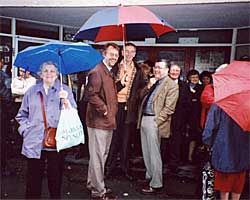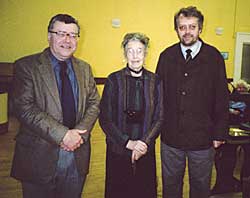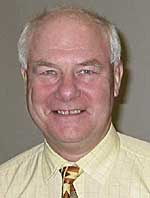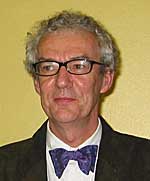Recent Society events and lectures, 2003/04
 |
Thorotonians in the rain
When does a lecture turn into an excursion? Our President, Neville Hoskins,
snapped this unlikely picture on 14 February when the lecture hall at the
YMCA had to be temporarily cleared due to a fire alarm. As it was raining
outside members and visitors attending the Maurice Barley lecture sheltered
across the road under the overhang of the former funeral directorship.
The picture opposite shows, from left to right, Ann Hoskins, chairman John
Beckett, Dr David Crook and Professor Christopher Dyer. The interruption
might have been shorter, but for the ten minutes it took the fire brigade
to arrive from roughly 50 yards along Shakespeare Street! Fortunately it
was a false alarm and Professor Dyer delivered the rest of his lecture
without further mishap.
John Beckett
The Maurice Barley Lecture: 14 February 2004
 |
Professor Christopher Dyer, with Mrs Diana Barley and Professor John Beckett |
‘Another Consumer Revolution? Economic and Social changes in the Later Middle Ages’
Professor Christopher Dyer, FBA, delivered the 13th Maurice Barley lecture on the subject of consumer demand in post-Black Death England. Professor Dyer, who is Professor of Regional and Local History at Leicester University, and Director of the Centre for English Local History, combined artefactual, documentary and archaeological evidence to show that in the 150 or so years following the great plague of 1348-9 consumers enjoyed considerable wealth, reflected in their spending power (on both food and other goods), their emulation of those socially ‘above’ them (through house styles, clothes etc.), their purchase of luxury goods including pottery and jewellery, and their pursuit of fashion, for which the best evidence is shoes. He argued that there was a great deal of consuming going on in these years, and that those historians who have seen economic growth as happening only when population was rising have failed to recognise that the two are not necessarily linked. In a lecture laced with contemporary examples, Professor Dyer gave a fascinating account of life in peasant and town households during the late Middle Ages. Maurice Barley would have enjoyed it immensely!
MERIDIAN LINE ACCURACY
Members will remember that when Mr Douglas Bateman spoke to the Society on Sundials, he showed us pictures of the rare meridian line at Bromley House. He had previously made it operational by installing an aperture plate in the south window, and was able last year to adjust it.
On 17 January this year bright winter sunshine at the appropriate time
enabled the accuracy of the installation to be demonstrated. Mr Bateman
had provided a table giving local Solar Noon, and as a clear image of the
sun was projected on to the door case it was fascinating to watch it move
slowly across to the upright bearing the vertical line, which bisected
the sun's image precisely at the forecast time of 12.14 and 28 seconds
GMT. Modern watches radio-controlled from Rugby are a great help
in this sort of exercise!
Neville Hoskins
MORE REPORTS OF LECTURES
 |
Dr Nigel Chapman |
Saturday 13 December: ‘Your Body Belongs to Me’: The Role of the Coroner: Dr Nigel Chapman
An excellent and informative presentation and talk was given by Dr Nigel
Chapman, Her Majesty's Coroner for Nottingham and Nottinghamshire, in December
2003. Although the subject matter was extremely serious and thought-provoking,
Dr Chapman was an entertaining speaker and members enjoyed a fascinating
glimpse into the work of this important figure in our county. Amongst some
of the awful facts of Dr Chapman's job, there were some hopeful signs such
as the drop in deaths on Nottingham’s ring road due to the installation
of speed cameras, and the decreased number of fire deaths because of the
introduction of domestic smoke detectors. Another role of the Coroner entails
making decisions on finds of ‘treasure’, and Dr Chapman also
illustrated this aspect of his work. This was another excellent lecture
to round off 2003's superb programme.
Barbara Cast
 |
Mr Peter Smith |
Saturday 10 January: The Nora Witham Lecture – 18th-Century Town Houses in Nottingham:
Mr Peter Smith. The first lecture of 2004 was presented by one of our members, Peter Smith, and attracted an unusually large audience. Peter has worked for English Heritage for many years, and is now their Designation Team Leader for the North, his brief covering listed buildings, ancient monuments, and historic gardens and landscapes from Doncaster to the Scottish Border.
The Victorians photographed many important buildings that were later destroyed, and Peter showed slides of long-lost houses around the Market Place and the Oriental Café on Wheeler Gate. Of particular interest were the rarely seen elevations and plans of the Plumtre House on Stoney Street, which preceded the more familiar version.
Peter showed photographs new to many of us, including the deplorable state
of Newdigate House’s interior before its restoration in the 1960s.
He reminded us that fresh information is still to be found, eg the plethora
of Venetian windows on Enfield House, Low Pavement, which he had thought
unique until a recent visit to Ludlow proved otherwise. This was a stimulating
lecture that left everyone feeling they had learned a great deal. A guided
walk will be arranged as a result of this lecture; further details soon.
Neville Hoskins